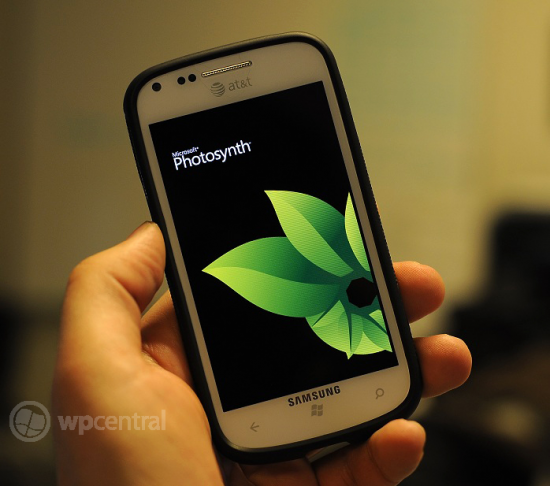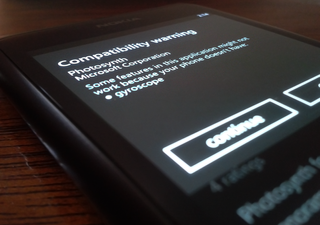Does having a gyroscope affect PhotoSynth?


When PhotoSynth for Windows Phone 7 hit the marketplace last week, we knew there would be discussions over the requirement of a gyroscope - and there was.
When users try download the app with a phone that doesn't have a gyroscope, they are presented with an error that reads "Some features in this application might not work because your phone doesn't have..gyroscope" - this does not stop the download though. Users of any 1st gen Windows Phone (HD7, Focus, Omnia 7, Trophy etc) will get this message, along with any users of a 2nd gen phone that is missing the gyroscope (most notably the Nokia Lumia 710 and 800). We don't know why the 710 and 800 do not have a gyro, but it may have simply come down to a cost-benefit decision, as the flagship 900 does have one. So what does a gryo do, and do you really need one? Read on to find out.
Most people confuse the accelerometer and gyroscope. Every Windows Phone, new and old, has an accelerometer. But only newer devices have a gyro. The Windows Phone 7 API has officially supported accelerometers since launch, but gyro support only came with Mango.
Without getting technical, the easiest way to explain the difference between these two is by example...
Imagine you are on a see-saw standing in the center blind folded. As your adolescent friends bounce up and down you will be able to tell what angle you are at, even though you can't see. This is not unlike an accelerometer - which measures the gravitational forces in effect on the device, and from that can determine what angle the device is at in relation to the ground. Now, hold your phone flat in your outstretched hands, and without tilting the phone, spin around on your toes. Now what you just did (besides embarrass yourself) would not have been picked up by an accelerometer. That's because an accelerometer can only tell you at what angle the phone is, but not if it's moving or not. So for the device to determine which way you spun around and if you are moving, it needs a gyro. It is the combination of these two types of motion/movements that PhotoSynth needs to determine where you are facing.
So by that logic, for PhotoSynth to work you would HAVE to have a gyro. Well, not exactly. Microsoft has given developers a fancy 'Motion' API which will combine the readings from the accelerometer, compass (not mentioned above, but included in most WP7's), and gyroscope and return very easy to use information about the phone's motion. It even goes so far as to compensate for the lack of a gyroscope by combining the other two values as best it can when a gyro is not present. And it turns out that their compensation works pretty well!
How well does it actually work in the real world? To find this out, we did a bunch of tests with two devices side by side, and compared the result. We used a Nokia Lumia 800 that does not have a gyro versus a Samsung Focus Flash, which does have one. After a number of trials we determined that there really isn't much difference at all, and recorded a video to prove it. Now, in the video you will notice that the Focus Flash occasionally complains about needing to be calibrated. This continued after calibrating, and even when testing with another Focus Flash. However, the problem only occurred when shooting the video, presumably because of some interference from the Lumia, but did not effect the results.
Get the Windows Central Newsletter
All the latest news, reviews, and guides for Windows and Xbox diehards.
Something else to note about the video is that we purposefully did not move around smoothly and slowly in order to give a combination of a real world test, and to try confuse the phones. When you are making your own, you results will vary, and it is definitely best to use some form of tripod. For more realistic results, be sure to check out George's great review of the app.
And here are the results from the two devices, with the Nokia Lumia 800 first:
and the Samsung Focus Flash:
So what have we learned?
- Don't try make panoramas with two phones next to each other, in a very scientific enclosure made with cardboard and excessive amounts of duct-tape. They will fight, plus for some reason looking too far up just produced a red square in the viewfinder.
- Use a tripod to keep a common point of origin, and try avoid scenes with varying light conditions - this mainly tripped the Lumia up in the tests above, but previous times the Flash suffered from the same.
- And finally: Having a gyro makes VERY LITTLE real-world difference. Instead of worrying about that, rather practice making panoramas!
Home to the most invested and passionate Microsoft fans, Windows Central is the next generation destination for news, reviews, advice and buying recommendations on the Windows, PC and Xbox ecosystems, following all products, apps, software, AI advancements, and accessories. We've been around for more than decade, and we take our jobs seriously. Windows Central writers and editors value accuracy and editorial independence in everything we do, never receiving compensation for coverage and never pulling punches.
